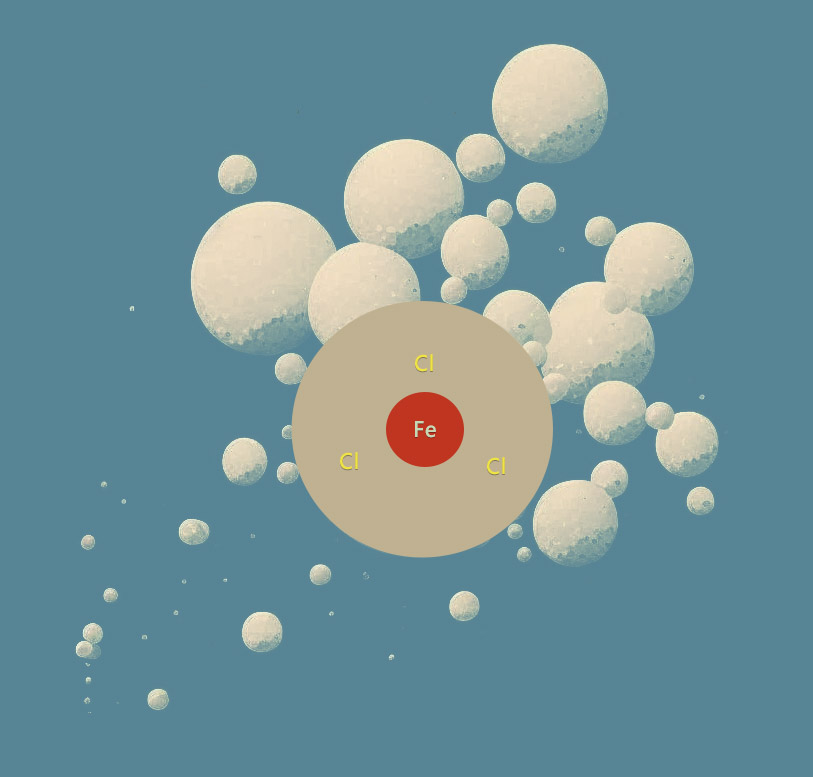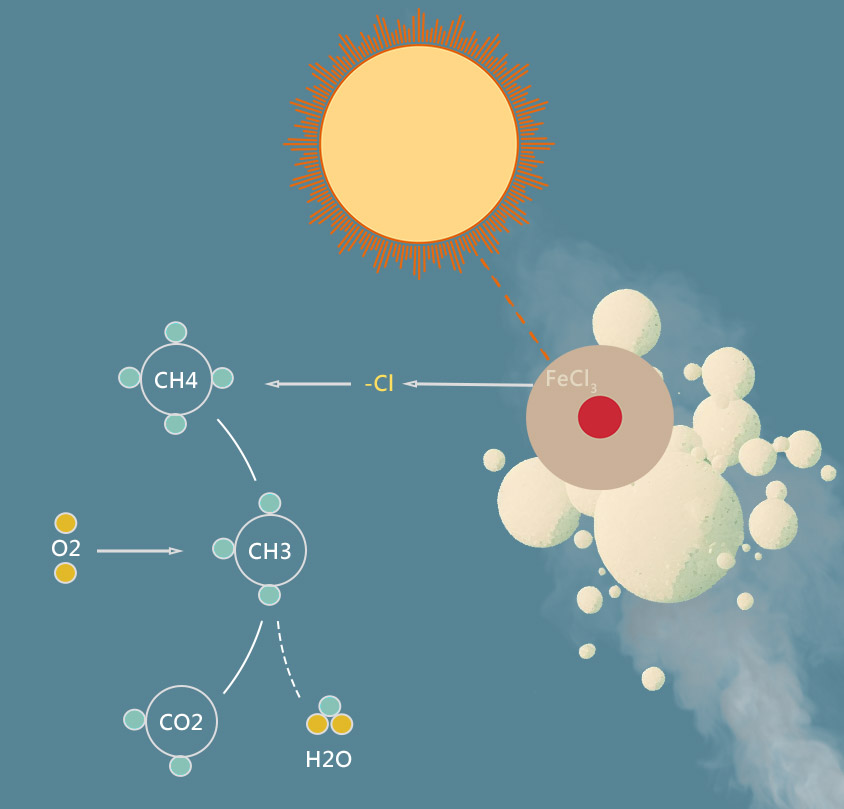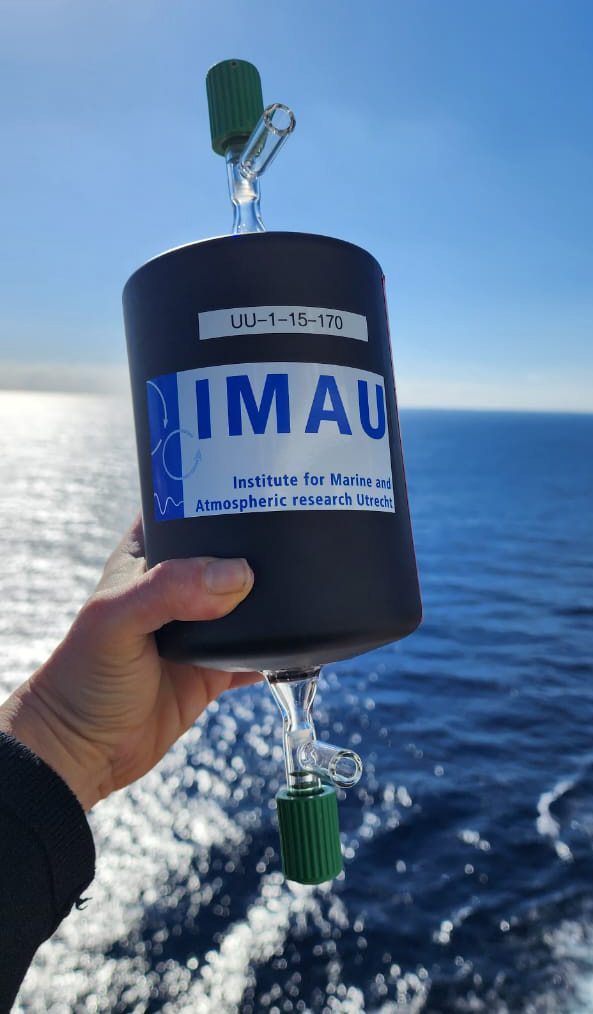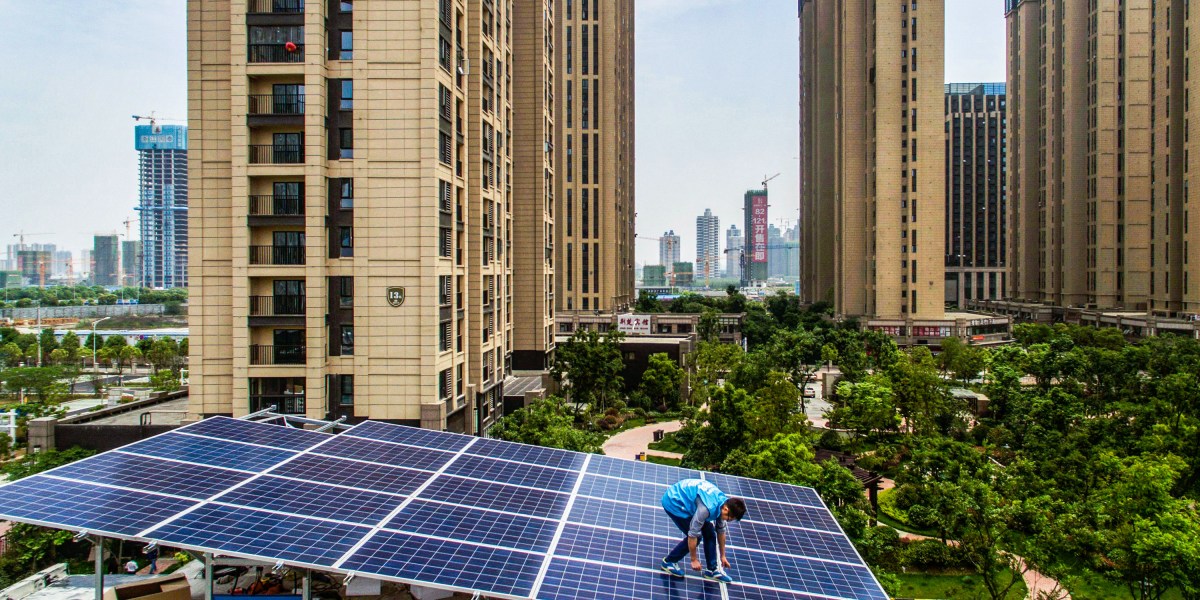These startups hope to spray iron particles above the ocean to fight climate change
Within the next 18 months, a Palo Alto–based startup wants to begin releasing a small quantity of iron-rich particles into the exhaust stream of a shipping vessel crossing the open ocean.
Blue Dot Change hopes to determine whether the particles will accelerate the destruction of methane, one of the most powerful greenhouse gases in the atmosphere. If it works, the four-person company hopes to begin spraying the particles on commercial scales within a year after that, says David Henkel-Wallace, the founder and chief executive.
The business is among a handful of small commercial ventures that are itching to test whether releasing similar particles could curb climate change, mimicking a phenomenon that some believe may have amplified ice ages. At least two other firms have also proposed outdoor experiments to evaluate this approach, MIT Technology Review has found.
There’s increasing academic work exploring this concept as well, driven by growing climate concerns and rising emissions of methane, which exerts about 85 times the warming effect of carbon dioxide over a 20 year-period. But most scientists in this area stress that the iron idea is speculative, limited so far to early lab and modeling work. Little is known about other effects that releasing the particles could cause, including potentially dangerous ones. And some argue that for-profit efforts to intervene in such a complex, little-understood area is rash and counterproductive at this stage.
“Any commercial venture that proposes we’re ready to do this in the field is premature and possibly misguided,” says Rob Jackson, a professor of Earth system science at Stanford, without addressing any specific company’s plans. “We don’t know enough about it. We don’t know enough about unexpected or unpredicted reactions. And we don’t know about social acceptance and the public’s view of this process.”

The basic concept behind the so-called iron salt aerosol method is that if we release iron-rich particles that contain chloride into the air, sunlight will irradiate them, producing chlorine radicals (uncharged molecules with an electron available for bonding). These, in turn, can drive reactions that convert methane into carbon dioxide in the atmosphere.
But it’s also possible the same particles could produce dangerous gases, spawn phytoplankton blooms, or brighten marine clouds, the last of which would muddy the line between greenhouse-gas removal and the more controversial field of solar geoengineering.
In addition, the chemistry is so complex that it’s not clear to some whether releasing these aerosols would increase or decrease methane concentrations, on balance.
“We have no idea what will happen there,” says Natalie Mahowald, an atmospheric scientist at Cornell and an expert on iron aerosols.
99.9%
Peter Fiekowsky, an engineer and entrepreneur who cofounded the Foundation for Climate Restoration, has emerged as a kind of Pied Piper of the iron salt aerosol method, advocating for groups to forge ahead in this field. He has funded academic research, acts as an advisor to several startups and is listed as a shareholder in one. He has also established a handful of related organizations himself.
Fiekowsky argues that resigning ourselves to merely meeting the UN climate panel’s temperature target, mainly through emissions cuts, doesn’t offer humanity “a decent chance of survival.” (That goal is set at a maximum of 2 ˚C above preindustrial levels, which will have severe impacts on humans and ecosystems, and could trigger certain climate tipping points. But the body of research doesn’t suggest that level of warming creates a risk of human extinction.)
Instead, Fiekowsky says, we should strive to restore the climate to preindustrial conditions through more aggressive interventions, including using iron to break up methane.
“Methane is really only important once you take on [the goal] of restoring the climate and making sure our kids survive,” he says.
Fiekowsky shares few of the doubts about iron salt aerosols or the wisdom of using them, asserting that the approach is safe, effective, cheap, and inevitable. He says it would cost only $1 billion to cut methane concentrations in half this way and puts the method’s odds of real-world success at 99.9%.
“How can I justify that?” he wrote in a follow-up email to MIT Technology Review. “A project only fails when people stop working on it. We’re not going to stop until we succeed. Period. That’s how we won WWII. That’s why I give us a 99.9% chance of success. The 0.1% chance of failure would be a nuclear war killing us first.”
With statements like these, Fiekowsky has earned a reputation as someone who passionately cares about addressing the problem but speaks with “overconfident grandiosity” about the effectiveness of certain solutions and the urgency of deploying them, says Ted Parson, an environmental law professor at the University of California, Los Angeles.
“He’s been, in my view, quick to assume that scientists and other researchers are overly cautious and dotting every ‘i’ and crossing every ‘t,” Parson says. “He wants to plunge ahead and solve the problem, and I’m concerned there’s not enough information about this yet to be confident it’s an effective and safe solution.”
‘Danger zone’
Despite their deep concerns over efforts to commercialize the concept at this point, Jackson and other scientists are in favor of careful, early-stage research exploring the potential to break down atmospheric methane, whether using iron salt aerosols or other methods.
Carbon dioxide has long overshadowed methane in the climate dialogue, because it plays a much larger overall role in driving warming. But methane has gained attention as emissions of the gas from industrial sources, burping cattle, deforestation, and natural systems like wetlands have climbed sharply over the past decade. At the same time, nations are not on pace to cut carbon dioxide emissions fast enough to avoid 2 ˚C of warming or more, even as the world grapples with increasingly severe wildfires, heat waves, and floods.
Because methane is so powerful and persists in the atmosphere for such a short period—years, compared with centuries for carbon dioxide—cutting emissions or destroying the gas in the air offers one of the few mechanisms we may have to meaningfully reduce near-term warming. A 40% decrease in methane concentrations by 2050 would shave about 0.4 °C off global warming, a 2021 study found.
“We’re on a warming trajectory of increasing human costs and Earth system risks, and in that danger zone, every fraction of a degree matters,” wrote Erika Reinhardt, the cofounder of Spark Climate Solutions, a San Francisco–based nonprofit, in an email.
Spark supports research in early-stage but probably crucial climate responses, including destruction or removal of methane in areas where it’s concentrated—like landfills and dairy farms—as well as in the open atmosphere. It has provided funding for a research collaboration that is doing a variety of atmospheric sampling, computer modeling, and lab work exploring the iron salt aerosol hypothesis. It includes scientists from the University of Copenhagen, Utrecht University, the Spanish National Research Council, and Cornell, including Mahowald.
But like others, Reinhardt stressed that the research is far too preliminary for commercial ventures to begin forging ahead.
“It’s an incredibly early field where there are still more questions than answers, but the questions are wildly important ones as we work to reduce climate risk,” she said.
The ‘iron hypothesis’
The general idea that iron may play a major role in dramatic climate shifts dates back decades.
During a 1988 lecture, the renowned oceanographer John Martin famously declared: “Give me a half tanker of iron, and I will give you an ice age.”
His “iron hypothesis,” put forth in a landmark 1990 paper, was that as the planet cooled during glacial periods, stronger winds picked up dust from drying continents and carried it deep into the oceans. Iron makes up about 3.5% of dust, and as the mineral reached the seas, it might have spawned massive phytoplankton blooms. These, in turn, would have sucked up carbon dioxide and buried it in the ocean, magnifying cooling.
It was a highly controversial concept at the time, but multiple lines of evidence in a growing body of research have backed it up over the ensuing decades.

A number of research groups and several commercial ventures have explored whether “ocean iron fertilization”—adding iron particles directly into the water—would work as a deliberate means of removing carbon dioxide from the atmosphere and reducing warming.
Methane levels also dropped during these glacial periods, ice core samples show. One hypothesis is that the same dust may have played a role as the iron reacted with salty air above the oceans, producing chloride-rich iron particles.
Several lab studies have found that sunlight, or at least an artificial version of it, induces reactions that produce chlorine from these sorts of particles. Chlorine is responsible for breaking down about 3% to 4% of methane in the atmosphere, converting it into carbon dioxide. Because that’s a much less powerful greenhouse gas, the overall warming effect is significantly reduced.
In a 2017 paper and several others, independent researchers Franz Dietrich Oeste, Renaud de Richter, and additional collaborators raised the possibility of mimicking this process as a means of “climate engineering.” The paper goes further, stating that iron particles could drive a variety of other potential cooling effects, including fertilizing the oceans as Martin described. They might also produce more—and more reflective—marine clouds, by providing nuclei that water vapor can condense upon. These brighter clouds might cast more sunlight back into space, theoretically cooling the planet.
All told, doubling the annual level of natural iron emissions into the troposphere “would enable the prevention or even reversal of global warming,” the paper claims.
“I always say, do it like nature does, and this is a process which nature does,” Oeste says.
Commercializing ‘climate repair’
Despite the concerns and unknowns about this approach, the studies have already inspired a handful of entrepreneurs.
Fiekowsky cofounded an earlier startup, Methane Oxidation Corp., that planned to use iron particles to restore methane concentrations to preindustrial levels, according to a spring 2021 application for funding from Stripe, the online payments company. It shuttered, but several of the listed team members moved on to Blue Dot Change.
That startup has been self-funded to date, but it’s now working to raise money for research efforts and the development of the equipment that would release particles, Henkel-Wallace says. During the planned field trials, the team hopes to release a few grams of ferric chloride and then measure the methane inside and outside the particle plume using known optical techniques, he says.
Henkel-Wallace hopes to develop the capacity to remove 100 million tons of methane per year by the end of 2027, which he says would require about 3,000 ships equipped with machines capable of emitting a few grams of particles per second.
He declined to talk in detail about the company’s business model, but he said it hopes to earn revenue from companies willing to pay for forms of “climate repair.”
At least two other for-profit companies have also emerged in this space.
A Swiss company, AMR AG, is doing lab research now and hopes to raise $2 million to $3 million to move forward with field experiments. The plan is to slowly release several kilograms of ferric chloride nanoparticles from a decommissioned oil platform, monitor the effects on methane, and repeat the effort several times to confirm the results. If the method proves safe and effective, the company would move forward with large-scale releases by building towers up to 400 meters high, equipped with machines that could release tons of particles per hour.
Oswald Petersen, the founder and chief executive of AMR AG, says there’s no environmental risk to a field trial of the size they’re proposing. He notes that briefly running a truck engine would produce roughly the same amount of pollution, though of different kinds.
The other company is an Australian venture, Iron Salt Aerosol, that several years ago proposed carrying out field trials in the Bass Strait, a channel separating Victoria, Australia, from Tasmania. But it decided not to pursue the effort “because of concerns that it would be too difficult to attribute any observed changes in atmospheric chemistry to the [iron salt aerosol] activity, and that the overall political governance framework is not ready to support this form of geoengineering,” one of the founders, Robert Tulip, wrote in an email to MIT Technology Review.
Oeste and de Richter are or have been advisors to each of the startups. Oeste says he has provided unpaid technical feedback so far, but he anticipates that a company would seek to license the technology if it chose to move forward. He says he co-owns a patent covering the method.
De Richter, who says he is also unpaid, stresses that his advice is primarily to proceed cautiously.
“Very often they are trying to get ahead of the science, so I try to slow them down,” he says of the companies. “We still need to do more research and more modeling. We don’t know yet if it works outdoors.”
UCLA’s Parson puts it more bluntly.
“My head is spinning by the immediacy of the leap from ‘Wow, this is an exciting area of research’ … to ‘We’re testing it now, we know it will work, and we’re creating a for-profit,’” he says.
An emergency tool
Researchers have raised a variety of potential dangers or complications that could result from spraying iron aerosols at large scales.
Cornell’s Mahowald notes that iron-rich particulate matter has direct human health risks, and that the dark particles could exert a warming effect that works against the goal of such interventions.
If the particles also fertilized the oceans, it might alter delicate and interconnected ecosystems in ways that are difficult to predict, some studies have found. And if it brightened marine clouds, it would likely draw greater scrutiny given the sensitivity around geoengineering approaches that aim to achieve cooling by reflecting away sunlight.
Chlorine is also harmful to humans and animals in high concentrations. And it’s highly reactive, which means it will readily break up or bond with many things besides methane.

“There are all kinds of undesirable chlorinated compounds we wouldn’t want floating around the atmosphere,” Stanford’s Jackson says. “Before we release chlorine radicals into bulk parcels of air, we need to do much more research on what else they will react with besides methane.”
Chlorine could also deplete ozone in the lower part of the atmosphere, which helps to produce the hydroxyl radicals that naturally break down the vast majority of the methane in the atmosphere, Mahowald says. That means it’s not clear whether releasing these particles would actually destroy more or less of the greenhouse gas, she says.
Several researchers said these reactions probably wouldn’t have much of an impact on the protective ozone layer in the stratosphere but add that this possibility should be carefully evaluated as well.
It’s also possible the particles wouldn’t stay aloft long enough to make much of a difference in methane levels, or that the approach might work only under certain circumstances, at certain times, in certain places.
Methane is relatively dilute in the atmosphere, at about 1.9 parts per million versus around 416 parts per million for carbon dioxide. There are techniques that may allow researchers to assess the impact of iron particles on atmospheric methane at small scales. But it could be challenging to reliably measure the effect of large-scale releases.
Even a particle plume that spans some tens of cubic kilometers “might appear as one pixel in a satellite map,” says Matthew Johnson, a professor of atmospheric chemistry at the University of Copenhagen who is involved in the Spark Climate-backed research effort. “It would be difficult to see a signal, much less to accurately quantify it.”
That, in turn, could present an obstacle to verifying how much methane such an intervention removed, which would be key to the credibility of any methane removal credits analogous to the sort used in carbon dioxide markets.
There is also a risk in doing work that alters the atmosphere through a for-profit, venture-funded model: there could be financial pressure to claim that it’s working well even if it’s not, and to downplay any negative effects.
“Proposing that it should be commercialized is way beyond what the science yet supports,” Reinhardt wrote. “And it’s not clear that commercialization will ever be an appropriate path to deployment.”
She says that the iron salt method may ultimately make more sense as a sort of “break glass in the case of emergency” tool if, as feared, continued warming triggers dangerous climate feedbacks that produce sharp increases in methane emissions from thawing permafrost, drying wetlands, or other sources.
‘Under fire’
Fiekowsky argues that the risks associated with the iron salt method are overblown relative to the risk of massive methane releases in the future, which could produce rapid surges in warming.
“Aerosols wash out of the atmosphere in a couple days to a couple weeks, so the risk of notable damage is low,” he wrote. “However, the risk of not using [iron salt aerosols] or other methane-oxidizing aerosols is high.”
Oeste says he expects the iron salt hypothesis will be vindicated. Further, he expects that “simple lab and field tests” will be able to answer concerns about ozone depletion and other possible side effects.
“Most new theories [come] under fire,” he wrote.
Henkel-Wallace also defended Blue Dot Change’s plans, arguing that field experiments are how we can begin resolving some of the unknowns. He said a for-profit model helps to ensure that the undertaking could be “self-sustaining.” But he stressed that the venture is still a long way from commercializing this approach, and won’t be able to if it can’t verify that the method removes methane.
He insists the company would simply cease spraying particles if there were unintended effects, since it is operating out of a sense of concern.
“I’m a human being on this planet too. I don’t want to put myself in danger,” he says. “The integrity of the work should come through.”
The law of the sea
There are international conventions regulating activities in the open ocean that could have harmful effects on the marine environment. Legal experts say they wouldn’t necessarily cover startups moving forward with small scale releases of iron salt particles, though the particulars may matter. Some believe, however, that efforts in this area could spark an international reaction either way.
Following earlier commercial proposals to use iron to fertilize the oceans, nations sought to limit such endeavors to small-scale scientific research, through various statements and agreements among the parties to a UN convention and a pair of maritime dumping treaties.
They’re not legally binding, but “it’s safe to say that commercial marine geoengineering would be contrary to the spirit of the statements agreed to in international forums,” says Jesse Reynolds, an expert on international environmental policy and author of The Governance of Solar Geoengineering: Managing Climate Change in the Anthropocene.
Henkel-Wallace says Blue Dot Change will identify relevant regulatory authorities for any experiment, and that it will go beyond what’s strictly required before moving forward with any projects.
He says the company has reached out to former regulators and lawyers for guidance, and that Blue Dot Change should prepare an environmental impact report “to the standard that a group like the [Environmental Protection Agency] would have required, if it did have jurisdiction.”
“Over the past year or so we’ve been planning under the assumption that we can find a way to be subject to US or possibly EU environmental supervision,” he wrote in an email.
Henkel-Wallace says that the company also intends to run any proposed field trials or deployments past the Climate Restoration Safety and Governance Board, which “provides review, approval, and oversight for projects capable of making a significant impact towards restoring global CO2 and methane levels.”
Observers question the independence of the advisory board, however. Fiekowsky “built” it and serves as chairman, and Blue Dot Change’s director of outreach is on it. Other executives at the organization were or are involved in Fiekowsky’s Foundation for Climate Restoration.
“I don’t think anyone could make a credible case that this is an independent board,” says Danny Cullenward, policy director at Carbon Plan, who has studied problems with market-based climate policies and carbon markets.
He says this board resembles earlier for-profit efforts to set up favorable forms of oversight for carbon offsets markets. “If your goal is to sell a product, you’ve got to say the product is real, good, and addresses concerns,” he says.
‘Close to collapse’
Henkel-Wallace says the board is “a stab” at setting up an independent regulatory regime to oversee such climate interventions, likening it to the institutional review boards that evaluate biomedical research involving humans. But he says he shares these concerns and acknowledges that it’s “still early to know” if the board will be “legitimate.”
Fiekowsky says the board’s purpose is “to ensure we restore the climate for future generations to flourish, and provide the public with accurate, relevant, and useful information.” He adds, “To succeed, projects must be safe, effective, legal, and ethical.”
Fiekowsky has made his own view on field experiments clear. He argues that the risks would be minimal, pointing to the favorable findings of an earlier environmental impact study funded by Methane Action, a nonprofit he cofounded.
“No one can imagine a bad side effect that holds up to the light of day,” he says.
Societal permission
The University of Copenhagen’s Johnson says that researchers can learn a lot more about the potential and risks of this approach without adding iron particles into the atmosphere through field experiments. Among other things, he said that researchers can sample and study the ample iron already in the air, as a result of natural sources like deserts and human activities such as shipping, heavy industry, and agriculture.
“Understanding these systems, already occurring in the atmosphere today, is the best way to move [iron salt aerosol] research forward,” he wrote in an email.
In fact, that work has already begun. In October, crews aboard several commercial ships streaming across the Atlantic began a yearlong effort to collect ocean air, using handheld glass flasks connected to pumps that suck down samples. They drop off crates filled with the flasks when the ships reach port, and the samples ultimately make their way to labs in the Netherlands for analysis as part of the research collaboration.

By studying the air samples back in the lab, the scientists hope to improve our basic understanding of atmospheric chemistry, explore whether the iron salt hypothesis holds up outside the lab, and assess what else these particles might do in the atmosphere, says Maarten van Herpen, executive director of Acacia Impact Innovation BV, a consulting firm that’s also involved in the effort.
Scientists fear that pushing ahead too hard and too fast in such a complex and touchy field could provoke a backlash against the basic concept, making it harder to carry out careful research on a tool that may well help reduce climate risks. Indeed, some argue that premature commercial stabs at both iron fertilization and solar geoengineering may have done just that.
Jackson stresses that this would be a drastic intervention fundamentally altering an essential global commons—and that simply demands exhaustive research and broad buy-in before plunging ahead.
“To make a dent at the million-ton scale, we will have to deploy these technologies widely,” he says. “We will need a lot more information before we do that safely. And we will need a lot more permission from the public to alter the Earth’s air.”




